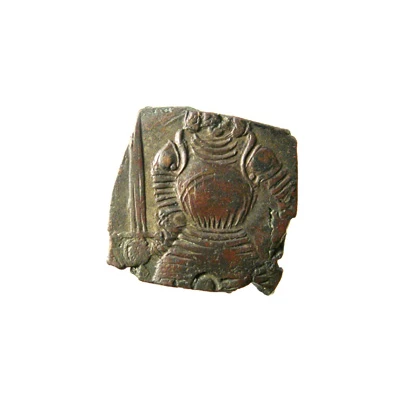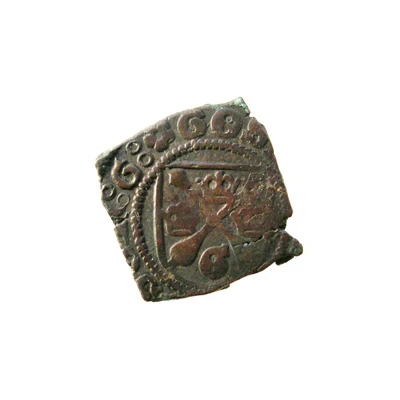


© www.myntkabinettet.se
18 Penningar "Liberation klippe" - Gustav Vasa ND
| Billon (.203 silver) | 2.20 g | - |
| Issuer | Sweden |
|---|---|
| Regent | Gustav I Vasa (1521-1523) |
| Type | Standard circulation coin |
| Years | 1521-1522 |
| Value | 18 Penningar (1⁄32) |
| Currency | Gyllen (1521-1534) |
| Composition | Billon (.203 silver) |
| Weight | 2.20 g |
| Size | 15 mm |
| Shape | Square (irregular) |
| Technique | Klippe |
| Demonetized | Yes |
| Updated | 2024-10-07 |
| Numista | N#106139 |
|---|---|
| Rarity index | 97% |
Reverse
Shield with Dalarna Arms (crossed arrows) with a 'G' between the arrows and the three crowns of Sweden. The shield is within a beaded circle with legend (if readable) outside.
Comment
Following the Stockholm Bloodbath in November 1520, Gustav Eriksson (Vasa), started an uprising in Dalarna against Denmark and Christian II. In February 1521 a group of several hundred rioters led by Gustav Eriksson raided Falun Mine which supplied them with silver and other necessities. In the chronicles of Peder Svart, written in the early 1560s, he mentions that Gustav established a mint at Hedemora in the spring of 1521. A wealthy local entrepreneur, Marten Skinnare, supported the revolt and became mintmaster. Klippes were struck with a value of 18 penningar, equivalent to 1 'old' örtug struck before 1478 and similar in style to the debased ones struck by Christian II in Malmo from 1518. Considering the extreme rarity of these coins, it is assumed that relatively few coins were produced. As a matter of fact, quite soon Gustav ordered mints to start copying the Danish klippe coins so they could circulate without danger. The copies were struck in larger numbers and can be distinguished from the Danish coins as the same obverse die was used for making the Danish copies and the Swedish klippes. Mints producing klippe coins were established in Hedemora, Söderköping and Västerås.Obverse
Type I: Full armored standing man with raised sword on shoulder and Globus Cruciger in his left hand.
Type II: Cuirassed knight holding raised sword at his right and Globus Cruciger in left hand.
Reverse
Type I "G" is in upper position while in Type II is in lower position.
An example of Type II
Interesting fact
One interesting fact about the 18 Penningar "Liberation klippe" coin is that it was issued during a time of great change and upheaval in Sweden. The coin was minted in 1521-1522, during the reign of Gustav Vasa, who had just led a successful rebellion against the Danish monarchy and established Sweden as an independent nation. The coin's design, which features a crowned shield with the letters "G" and "V" on either side, symbolizes the newfound independence and power of Sweden.